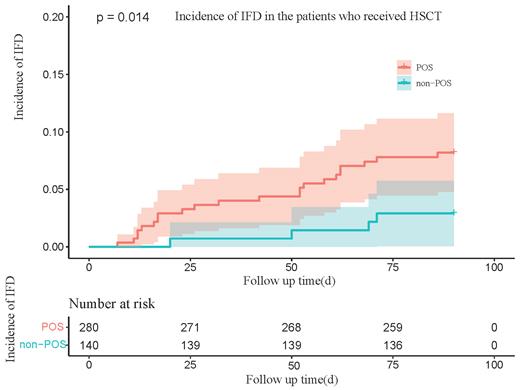Introduction The risk of fungal infection in patients after HSCT is high. Prophylactic use of antifungal drugs can significantly reduce the occurrence of invasive fungal disease (IFD) and potential IFD-related mortality. Posaconazole oral suspension shows good preventive effects for patients with neutropenia and severe GVHD . However, there is still a lack of prospective research confirming the effectiveness of posaconazole enteric-coated tablets in preventing fungal infections in HSCT patients.
Methods This study is a prospective, non-randomized, single-arm study. 143 patients who received hematopoietic stem cell transplantation at the Transplantation Center of Blood Diseases Hospital, the Chinese Academy of Medical Sciences from December, 2020 to May, 2022 were included. Posaconazole enteric-coated tablets were administered orally at a dose of 300mg QD (double dose for the first day) for the prevention of pulmonary invasive fungal disease from the first day to the 90th day after transplantation. The study collected baseline data, serum posaconazole concentrations, UGT1A4*3 genotype of the involved patients and observed whether pulmonary invasive fungal disease occurred. Retrospective data on the use of other antifungal drugs for the prevention of pulmonary invasive fungal disease at the center were collected as a control group for comparison. After applying propensity score matching at a ratio of 1:2, a comparative analysis was conducted on 140 cases in the posaconazole enteric-coated tablets group and 280 cases in the non-posaconazole group.
Results Among the 143 patients who were included in the clinical trial and treated with posaconazole enteric-coated tablets alone for the prevention of fungal infection from day 1 to day 90 after hematopoietic stem cell transplantation, 4 cases developed invasive pulmonary fungal infection, including 1 case of mold and 3 cases of undefined pathogens, with a breakthrough rate of 2.80%, significantly lower than the historical control group breakthrough rate of 7.86% in the non-posaconazole group (P=0.014). In the 90 days after transplantation, a total of 246 measurements of posaconazole blood concentration were performed in the 143 patients in the clinical trial group. The average blood drug concentrations on the 4th, 8th, 15th, 22nd, and 30th day were 930.97 ng/ml, 1143.97 ng/ml, 1569.8 ng/ml, 1652.57 ng/ml, and 1644.75 ng/ml respectively. The blood drug concentration of posaconazole enteric-coated tablets tended to stabilize since the 15th day after treatment. In the 37 patients who tested the UGT1A4*3 genotype, there was no significant correlation between UGT1A4*3 gene polymorphism and posaconazole blood drug concentration. In terms of adverse reactions, the incidence of liver adverse events in this clinical study was 1.4%. Except for a slight increase in ALT after the 14-day medication (18.29 U/L vs. 26.22 U/L, P<0.001), there were no differences in other liver and kidney function laboratory test before and after treatment.
Conclusion Posaconazole enteric-coated tablets is a highly safe prophylactic drug for invasive pulmonary fungal infections after HSCT, and its efficacy is superior to other antifungal prophylaxis regimens. Posaconazole enteric-coated tablet blood drug concentration in transplant patients gradually rose over time and tended to stabilize after 15 days of medication. The UGT1A4*3 gene polymorphism has no effect on the blood drug concentration of posaconazole enteric-coated tablets.
Keywords Posaconazole enteric-coated tablets, hematopoietic stem cell transplantation, pulmonary invasive fungal disease
Disclosures
No relevant conflicts of interest to declare.


